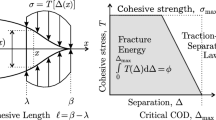Within the framework of a cohesive model, we determine the parameters of the process zone in the binding material at the tip of an interface crack originating from the corner point of the broken interface of two different homogeneous isotropic materials. The indicated zone is modeled by the line of discontinuity of displacements where the stresses satisfy the Mises–Hill fracture criterion. By the Mellin integral transformation, we reduce the problem to the Wiener–Hopf vector equation whose analytic solution is found by the method of successive approximations. We deduce the equations for the length of the process zone and the phase length of stresses in this zone, as well as the expression for the crack-tip opening displacement. Finally, we perform the numerical analysis of parameters of the process zone.
Similar content being viewed by others

References
F. D. Gakhov, Boundary Value Problems, Dover, New York (1990).
М. V. Dudyk, “Analytic solution of the plane problem of cohesive process zone in a binding material near the tip of an interface crack,” Visn. Odes. Nats. Univ. Mat. Mekh., 18, Issue 4(20), 84–95 (2013); http://lib.onu.edu.ua/en/issledovaniya-v-matematike-imehanike/.
М. V. Dudyk and Yu. V. Dikhtyarenko, “Development of a prefracture zone from an interface crack at a corner point of an interface of two elastic media,” Mat. Met. Fiz.-Mekh. Polya, 54, No. 2, 103–114 (2011); English translation: J. Math. Sci., 184, No. 2, 121–135 (2012); https://doi.org/10.1007/s10958-012-0857-5.
М. V. Dudyk, Yu. V. Dikhtyarenko, and V. M. Dyakon, “Influence of the plasticity of a joining material on the kink of an interface crack at the corner point of the interface of media,” Fiz.-Khim. Mekh. Mater., 50, No. 1, 45–52 (2014); English translation: Mater. Sci., 50, No. 1, 46–54 (2014).
A. A. Kaminsky, М. V. Dudik, and L. A. Kipnis, “On the direction of development of a thin fracture process zone at the tip of an interface crack between dissimilar media,” Prikl. Mekh., 42, No. 2, 14–23 (2006); English translation: Int. Appl. Mech., 42, No. 2, 136–144 (2006).
A. A. Kaminsky, М. V. Dudik, and L. A. Kipnis, “Initial kinking of an interface crack between two elastic media,” Prikl. Mekh., 43, No. 10, 28–41 (2007); English translation: Int. Appl. Mech., 43, No. 10, 1090–1099 (2007).
A. A. Kaminsky, М. V. Dudik, and L. A. Kipnis, “Investigation of the process zone near the tip of an interface crack in the elastic body in shear within the framework of the complex model,” Mat. Met. Fiz.-Mekh. Polya, 57, No. 4, 95–108 (2014); English translation: J. Math. Sci., 220, No. 2, 117–132 (2017); https://doi.org/10.1007/s10958-016-3171-9.
B. Noble, Methods Based on the Wiener–Hopf Technique for the Solution of Partial Differential Equations, Pergamon Press, London (1958).
V. V. Panasyuk, Limit Equilibrium of Brittle Bodies with Cracks [in Russian], Naukova Dumka, Kiev (1968).
V. V. Panasyuk and M. P. Savruk, “Model for plasticity bands in elastoplastic failure mechanics,” Fiz.-Khim. Mekh. Mater., 28, No. 1, 49–68 (1992); English translation: Sov. Mater. Sci., 28, No. 1, 41–57 (1992).
M. V. Dudyk and L. A. Kipnis, “Model of the structure of the near tip area of interface crack in a piece-homogeneous elastic-plastic body,” Strength, Fract. Complex., 11, No. 1, 31–50 (2018); https://doi.org/10.3233/SFC-180211.
Z.-H. Jin and C. T. Sun, “Cohesive zone modeling of interface fracture in elastic bi-materials,” Eng. Fract. Mech., 72, No. 12, 1805–1817 (2005).
A. A. Khrapkov, Wiener–Hopf Method in Mixed Elasticity Theory Problems, B. E. Vedeneev VNIIG Publ. House, St.-Petersburg (2001).
K. Kishimoto, M. Omiya, and W. Yang, “Fracture mechanics of binding interface: a cohesive zone model,” Sens. Actuat. A, 99, 198–206 (2002).
M. J. Lee, T. M. Cho, W. S. Kim, B. C. Lee, and J. J. Lee, “Determination of cohesive parameters for a mixed-mode cohesive zone model,” Int. J. Adhes. Adhes., 30, No. 5, 322–328 (2010).
J. R. Rice, “Elastic fracture mechanics concepts for interface cracks,” Trans. ASME. J. Appl. Mech., 55, No. 1, 98–103 (1988).
C. T. Sun and Z.-H. Jin, “Modeling of composite fracture using cohesive zone and bringing models,” Compos. Sci. Technol., 66, No. 10, 1297–1302 (2006).
V. Tvergaard, “Cohesive zone representations of failure between elastic or rigid solids and ductile solids,” Eng. Fract. Mech., 70, No. 14, 1859–1868 (2003).
V. Tvergaard, “Influence of plasticity on interface toughness in a layered solid with residual stresses,” Int. J. Solids Struct., 40, No. 21, 5769–5779 (2003).
V. Tvergaard and J. W. Hutchinson, “On the toughness of ductile adhesive joints,” J. Mech. Phys. Solids, 44, No. 5, 789–800 (1996).
B. H. Veitch and I. D. Abrahams, “On the commutative factorization of n × n matrix Wiener–Hopf kernels with distinct eigenvalues,” Proc. Math. Phys. Eng. Sci. (Proc. R. Soc. A), 463, No. 2078, 613–639 (2007).
Author information
Authors and Affiliations
Corresponding author
Additional information
Translated from Matematychni Metody ta Fizyko-Mekhanichni Polya, Vol. 62, No. 4, pp. 112–123, October–December, 2019.
Rights and permissions
Springer Nature or its licensor holds exclusive rights to this article under a publishing agreement with the author(s) or other rightsholder(s); author self-archiving of the accepted manuscript version of this article is solely governed by the terms of such publishing agreement and applicable law.
About this article
Cite this article
Kamins’kyi, A.O., Dudyk, M.V. & Reshitnyk, Y.V. Cohesive Model of the Process Zone Near the Tip of a Crack Originating from a Corner Point of the Broken Interface. J Math Sci 265, 474–488 (2022). https://doi.org/10.1007/s10958-022-06065-7
Received:
Published:
Issue Date:
DOI: https://doi.org/10.1007/s10958-022-06065-7


